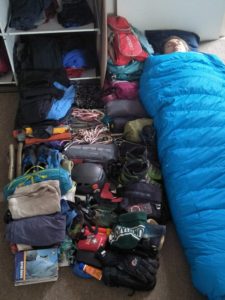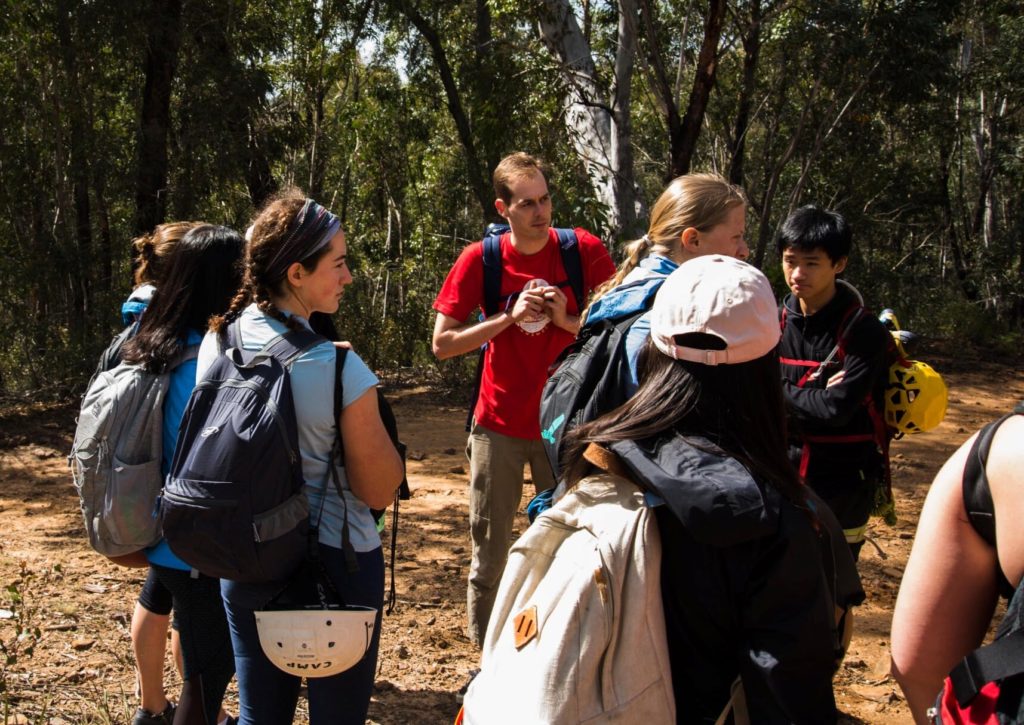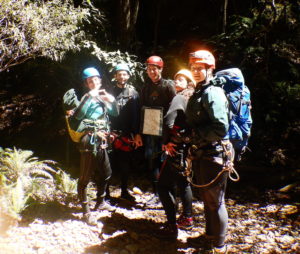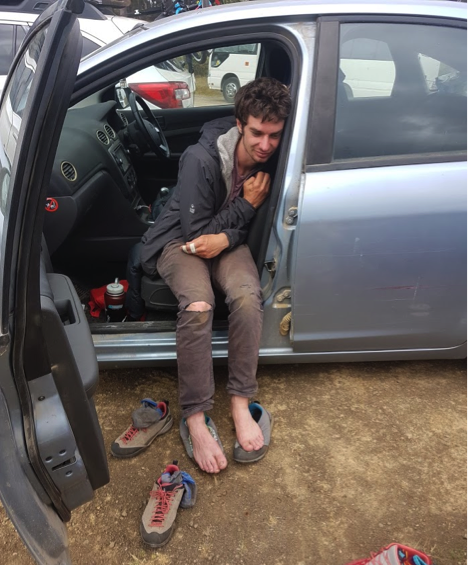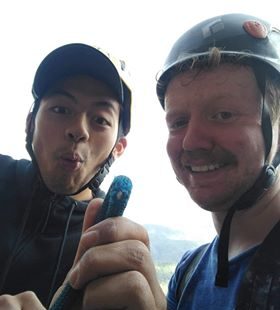These pages do not equip you with the skills to lead or go on a trip. The author and club accept no responsibility for the actions of those relying on the information herein. Outdoors activities are undertaken at an individual’s own risk. These pages contain general tips and advice. Use it as a guide to know what is advisable to have with you and what you should learn from appropriate courses and experienced leaders.
Trip leading is a great way to get more involved and give back to the Club, and comes with its own perks such as subsidised skills and first aid training.
If you're think about becoming a trip leader, talk to an exec or a current trip leader! We're always happy to help new members develop their skills and start leading trips. All new trip leaders lead a few trips assisting a more experienced trip leader, before heading into the big wide world by yourselves.
Below is a generic (incomplete) list of things you should always think about when running any club trip. For additional tips specific to many of the types of trips the club runs, refer to the pages below:
Trip Leader Checklist
Before the Trip:
- Ensure you are qualified to lead this type of trip (speak to an exec if you are unsure), or team up with a more experienced trip leader.
- You have the freedom to create unusual or extra trips that are not listed in the trip calendar. Consult exec members if you are unsure.
- Have a minimum of two trip leaders on each trip.
- At least one trip leader on each trip should be first aid certified.
- Decide on the details of your trip:
- Where?
- Lead trips that you have undertaken before, unless you are highly experienced. (You must tell your emergency contact if you are leading a trip to somewhere you haven’t been to).
- Check for any closures within the area you are heading to.
- When?
- Duration? Check sunset time and leave earlier than you think.
- Trip Level (Beginner, Intermediate, Advanced)?
- Capacity? Know max numbers and stick to them.
- Where?
- Let an emergency contact know your plans - please take this seriously.
- Let a reliable person (ideally a fellow trip leader who knows the area, knows you well AND is not on a trip that day!) know:
-
- Where you are going (route and side trips).
- Where you plan to start, stop and camp.
- When you expect to start, when you expect to be back/check in by, and most importantly, at what time they should send for help if they haven't heard from you.
- How many people are going (they all must sign up for the trip on the website).
- Rego of the car you (the trip leader) intend to travel in where will it be parked (if different from start location).
-
- There is a good discussion between trip leaders here regarding what your emergency contact should know and when to call emergency services.
- The more you tell your emergency contact, the safer you will be and the less likely they will be to worry unnecessarily.
- Let a reliable person (ideally a fellow trip leader who knows the area, knows you well AND is not on a trip that day!) know:
- Post your trip on the website (link only available to current trip leaders).
- Then post a link to your event on the facebook page with a short snazzy description to get people keen.
- Remember to set the featured image, so your post looks good on facebook.
- Select participants (link only available to current trip leaders):
- Ensure that participants have the requisite skills for your trip. Ask what trips have they been to before.
- Experience stacking: Mix up the experience of participants.
- Attempt to balance the ratio of male/female participants.
- Ensure you have enough drivers/cars for the trip, if necessary.
- Remember to sign up for your own trip! This is necessary for you to be covered by the Club's insurance should anything go wrong.
- Get in touch with your trip participants:
- Send out your phone number or use Facebook Messenger to create a contact pathway.
- Let everyone know what gear is required, whether you will collect it or if they must do so.
- 1 Emergency Blanket per person is compulsory for all canyons and any trip where you may get stuck out in the cold (multipitching, backcountry, etc.). Emergency blankets are available for purchase at gear cupboard for $5.
- Find out what gear each person already owns.
- Be aware of medical conditions of participants and remind them to take their personal meds with them.
- Make a clear meeting point and time. Don’t wait too long for people who are late if the trip could get more risky (canyoning, multipitching, etc.).
- Check the weather forecast, a be prepared to postpone or call off the trip if it will become dangerous.
- Pack your mandatory gear:
- PLB: 100% compulsory for canyons and remote trips.
- First Aid Kit, available at the gear cupboard.
- Headtorch (+ extra batteries).
- Printed map and compass (for most trips apart from climbing).
Before Leaving the Cars:
- Introduce yourself and your fellow trip leaders, as well as any competent members of the trip so new members know who can assist them as needed. Be friendly!
- Ask the trip participants if they have any medical issues that you need to know about.
- Trip leaders should be conscious that this advice may not want to be given in a group setting, so ask at the beginning of the trip but give people the opportunity to come up to you when they feel comfortable.
- Trip leaders should inquire about the following:
- Medical histories that may be relevant for a club trip (e.g. asthma, etc.).
- Locations of medications, especially for anaphylaxis.
- Whether participants may be fasting for any reason (e.g. during Ramadan), as the reduced food and water intake could impact their health on the trip.
- Advise everyone as to the location of your first aid kit and PLB (e.g. it's in the top of my red pack).
- Trip leaders should make it clear that you are there to care for the participant’s safety and wellbeing for the duration of the trip, and that they can, and should, come to you with any potential safety concerns, no matter how minor.
- Remind people that the activities that we undertake are inherently dangerous and they should always be on alert and listen to instructions.
- Double check all participants have appropriate gear.
- Where applicable ask participants to use the amenities before entering a crag or canyon.
- Remember that people come from different backgrounds and may have different communication styles and social expectations. Be kind and respectful to all trip participants, but expect the same in kind, you don’t have to put up with poor behaviour.
During the Trip:
- Check in with each participant occasionally. Ask if they are warm enough and enjoying themselves.
- Asking if someone is cold or feeling unwell early can help avoid a more serious situation if left unnoticed.
- Keep an eye on any potentially dangerous weather.
- Speak up if you spot anything potentially unsafe, even if it's the actions of another trip leader.
- Pick up skills from more experienced trip leaders and ask questions.
- If you're experienced, encourage enthusiastic trip participants to do the same.
- As a trip leader, you are in charge and need to set a good example. Participants will follow your lead.
- Always act safely, even when it's only your safety at risk..
- Don’t show off, don’t push on when you’re exhausted, don’t take risks..
- Wear your helmet..
- Keep out of the sun..
- Drink regularly..
- Stay on track..
- Take your rubbish with you. Follow Leave No Trace principles.
After the Trip:
- Ask participants to return any club gear they borrowed for the trip clean and dry.
- Ensure all club gear you borrowed for the trip gets returned promptly.
- It's not enough to leave it in someone's car who said they would return it. Follow up with them to confirm it was returned.
- If any gear was potentially damaged, label it with a note attached with masking tape and alert the Gear Officers to the potential damage when you return it. We don't want unsafe gear being lent out to the next trip.
- Send any sick photos and videos to the Social Media Officer to post on the club instagram and encourage new members into the club.
- Write up a trip report for the website if you're feeling generous with your time (link only available to current trip leaders).
- Start planning your next adventure.
If Anything Goes Wrong:
- Do your best to handle the situation, call for help if necessary and stay calm.
- If any incident, near miss or gear failure/damage occurred throughout the trip, fill out the incident report form.
- For any accidents at all, refer to the UNSWOC Incident Management and Safety Protocol.
- Talk to other experienced trip leaders, and help each other learn what we can do to avoid similar situations in the future.
Thanks to all the Trip Leaders who helped put together this list.




